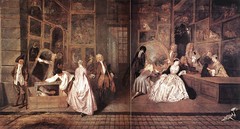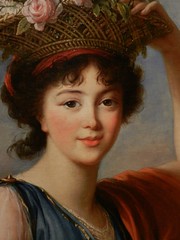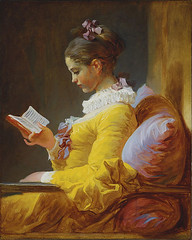![]()
![]()
![]()
Use LEFT and RIGHT arrow keys to navigate between flashcards;
Use UP and DOWN arrow keys to flip the card;
H to show hint;
A reads text to speech;
18 Cards in this Set
- Front
- Back
- 3rd side (hint)

Jean-Antoine Watteau
|
Roccoco, main (Flemish) painter
- Intimate world of the aristicracy. - Air, lightness and grace (contrast to Baroque) - Some mythological allusions > depictions of classical themes. - Smaller, gentler moments - Often involving love, eroticism, romantic, sentimental. - Softer pastels (then intense colour of Baroque) evoked nostalgia, melancholy. - More suited to interior furniture. less monumental. - New art collectors from the world of upper bourgieos. Shopped in commercial areas |

|
|
|
Francois Boucher
|
Roccoco.
- Unabated sexuality - voluptous nudes. Realistic portrail, no classical trappings. - masterfully exposed the lax morals of french upper class were becoming increasingly offensive |

|
|
|
Elizabeth Louise Vigee-Lebrun
|
Became leading societies painter in later century.
- one of few famous female painters. - portrait of Marie Antoinette - some neoclassical inspiration. |

|
|

Jean Honore Fragonard
|
Student of Boucher
Revived Watteaus graceful debonair themes. -The lover crowned - Finely detailed background of nature (prefigures Romanticism) - Fascinated with the movement of light on surfaces. |

|
|
|
Roccoco interiors
|
Rocaille: Fanciful stuco ornament in the shapes of ribbons, leaves, stems, flowers. Interlaces, arabesques. Solid surfaces to look more like fleeting illusions. Mirros and chandeliers added to this effect. > Glittering, luxurious setting for ultra refined society.
|
|
|
|
Jacques Germain Soufflot
|
Late 18th century France adopted Neoclassical architecture as well.
- designed buildings based on Roman Temples. - reliance on architectural details rather than sculptural decoration. - Pure roman forms. - Pantheon in Paris. Dome was inspired by architecture in London > sign that English architecture had come of age. Based on the dome of St. Pauls Church in London. |

|
|
|
William Hogarth
|
English response to Roccoco which was not in vogue.
- social satire of aristocracy - moralistic middle class. > Marriage a la Mode Portrays a loveless marriage and bitter consequences of arranged marriage. |

|
|
|
Neoclassical Painting 1775
|
Began to be promoted by the Salon After middle 18th century, roccoco gave way to neo classical.
- Facination new archeological discoveries. (pompeii) - rejection of roccoco. - scholars began writing about greek art/architecture. Joachim Winckelmann - History of art Led to founding of academic disciplin of Art History. |
|
|

Jacques Louis David
|
Purified classical style.
Perspective, anatomy and life drawing. - Inspirational model was Poussin. - Classical themes - Linear perspective. - Frozen sculptures, portraying strong colours. - Ideals of balance, simplicity and restraint. - None could compare to David. - Occasional intermingling with Roccoco |
- The Death of Socrates
- Oath of Horatii Tention between civic duty and and family loyalty. |
|
|
Robert Adam
|
- Neo classical style in interior decor reigning favourite from 1760-1800
- reinvigorated the classicism that had dominated British architecture since 1600 with forms and motives gathered during archeological investigations. -Kenwood House |
|
|
|
Enlightenment Literature
|
Dominated by French authors and French language.
Shared ideas with the philosophes. Wrote for growing middle class. Mission to liberate consiousness of readers. State censorship avoiding by disguise. |
Montesquieu: - Persian Letters. Rideculed French despotism, aristocracy and church through the eyes of the Persians.
- Spirit of the laws Compares systems of government and underlying principles. > Seperation of government functions should protect against despotic rule. Rousseau: Confessions. Emotional truthfulness. autobiography was changed forever. Voltaire: Essays on Customs, Candide |
|
|
Neoclassicism in English Literature
|
Alexander Pope
Poems celebrate order and decorum prized by the middle class. Leading spokesman for reason as human value. Classical learning, good sense and taste. Verses marked by optimistic satire and wit. - Essay on Man Theodicee, great chain of being. Middle of the chain. 2 natures pull on humans. Fatalistic optimism challenges by Dr. Pangloss in Candide. |
Edward Gibbons
- Decline and Fall of the Roman Empire His history praises secularism (and points to Christianity as one of the prime causes of the downfall of Rome) |
|
|
Rise of the Novel
|
Development in England. Hallmark: Realism Individual experience key. Accute representation of real life events.
- Focus on individuals rather than universal types. = Particular circumstances rather than customery. - Plot development of characters over the course of minutely observed time. |
Samuel Richardson, Henry Fielding
Read by many (women) Since Richardson and Fielding, Novels about ordinary people remained the standard. Richardson: Focus on love between sexes. Fielding: robust comedy |
|
|
Roccoco music (French)
|
Light and charming as opposed to baroque Style gallant
Harpsichord. Invention of piano by Bartholomeo Cristofori or pianoforte (as it could adjust the loudness of sound) Ramue and Couperin |
|
|
|
Classical style music
|
Surpassed Roccoco second half of 18th century.
- emphasis on form and structure - Sonata form (piece writen in 3 sections: exposition, development and recapitulation.) - Symphony and concerto and sonata Often three pieces varying in Key, tempo and mood. Retained love of Roccoco elegant melodic lines but by using Sonata form, added depth. Haydn and Mozart |
|
|
|
Frans Joseph Haydn 1732-1809
|
Largely responsible for development of Sonata form.
- supreme innovation was to allow each instrument to independence from the rest. - His string quartets (first and second violin viola and cello) became the norm. |
|
|
|
Wolfgang Amadeus Mozart 1756-1791
|
Master of Classical style.
Not because he invented things, but for his inimitable talent for composing. His works embody the spirit of enlightenment. Fullest expression in Opera. Especially comic ones. Masterpiece in this genre - The Marriage of Figaro |
|
|
|
Mary Wollstonecraft
|
- A vindication of the rights of women 1792
Democrat and opposed to hierarchy (like Rousseau). Thus also the hierarchy of man/woman. 19th century reformers would gradually start to implement changes. |
|

